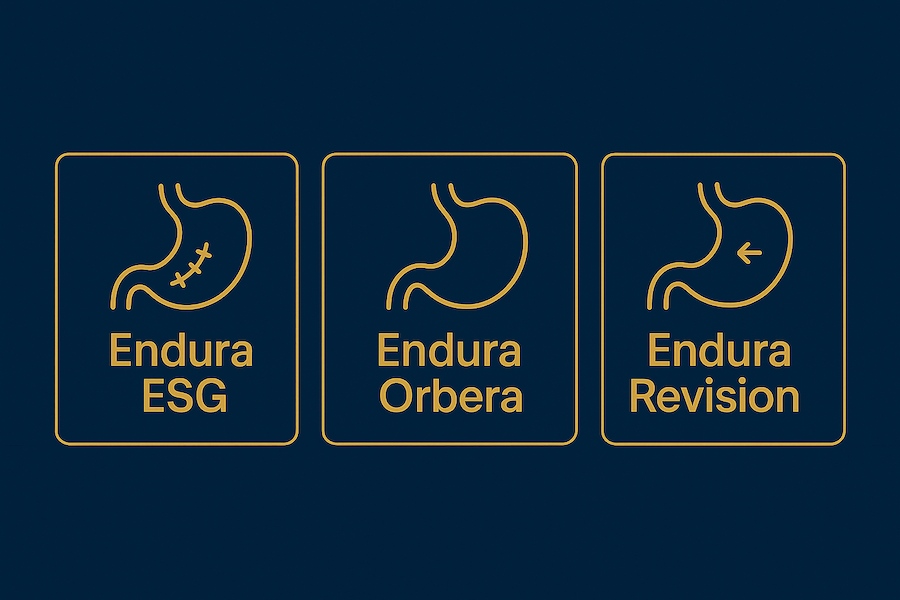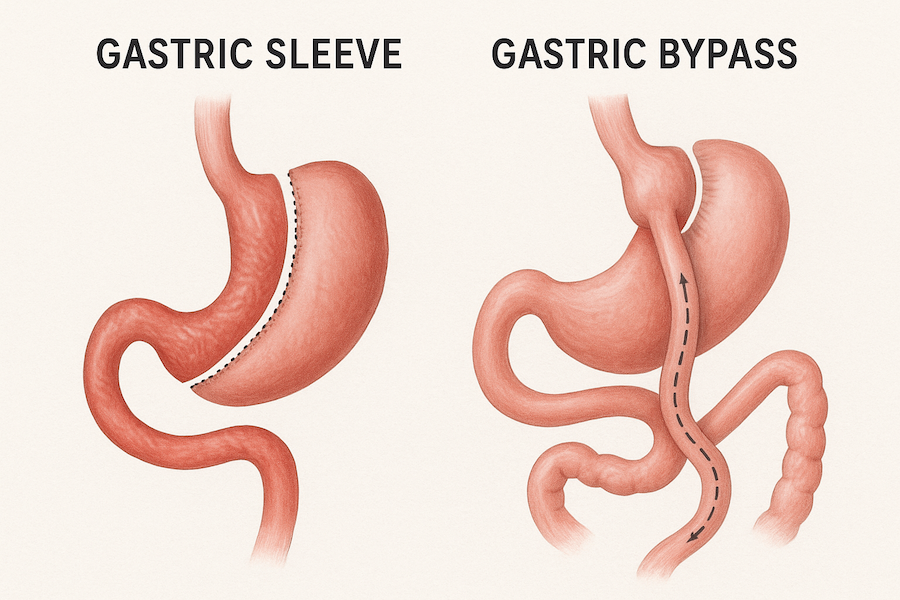What is Endura Weight Loss?
Learn more about Endura, non-surgical weight loss solutions by Boston Scientific featuring ESG, Orbera, and Revision for safe, lasting results.

Bariendo Team
Team @ Bariendo
Endura is Boston Scientific’s new name for a category of cutting-edge, non-surgical weight loss procedures performed endoscopically—through the mouth, not through incisions. It marks a major step forward in obesity treatment, offering patients a powerful tool for long-term weight loss without the need for traditional surgery or lifelong medications. Whether you’re just beginning your weight loss journey or looking to revise a past surgery, Endura offers options that are safer, faster to recover from, and just as impactful when paired with healthy lifestyle changes.
What Makes Endura Unique?
All Endura procedures share a common principle: they are endoscopic and non-surgical. That means no cutting, no external scars, and no hospital stays. Because these are outpatient procedures, patients typically return home the same day and recover quickly—often in a matter of days rather than weeks. This reduced downtime, combined with a lower risk of complications compared to surgery, makes Endura a compelling choice for many people who want real results without the risks or permanence of traditional weight loss surgery.
The Three Types of Endura Procedures
Boston Scientific’s Endura suite is made up of three main types of procedures: Endura ESG, Endura Orbera, and Endura Revision. Each of these approaches targets a different need but is united by the goal of helping patients lose weight by reducing the effective size of the stomach.
Endura ESG (Endoscopic Sleeve Gastroplasty)
Known by medical professionals as “endoscopic sleeve gastroplasty,” Endura ESG is a procedure that uses a flexible tube called an endoscope to reduce the size of your stomach from the inside. This is done through your mouth, with no external incisions or cutting involved. The stomach is reshaped to be smaller, which leads to reduced hunger, earlier satiety, and long-term weight loss.
The procedure was first performed in humans in 2012 by Dr. Christopher Thompson—now co-founder of Bariendo—and received FDA approval in 2022. Since then, ESG has become one of the most effective and durable non-surgical weight loss procedures available.
Endura Orbera (Gastric Balloon)
Endura Orbera is a non-surgical procedure that involves placing a soft balloon in the stomach and filling it with saline. This balloon takes up space in the stomach, helping you feel full sooner and reducing the amount of food you eat. Unlike ESG, this is a temporary solution—the balloon must be removed after six months.
Patients typically lose around 10% of their body weight with Orbera. However, it’s important to note that many people experience weight regain after the balloon is removed. That’s why it’s critical to use the six months with the balloon in place to focus on lasting behavior changes, including better nutrition habits, consistent movement, and mindful eating. Orbera is a great way to jumpstart progress, but your success will depend on the long-term changes you make while the tool is in place.
Endura Revision (Non-Surgical Bariatric Tune-Ups)
Weight regain after bariatric surgery like gastric bypass or sleeve gastrectomy is more common than many people realize. Endura Revision was developed specifically to help those patients get back on track—without another surgery.
There are two main types of revision: SIS (Sleeve-in-Sleeve) and TORe (Transoral Outlet Reduction). SIS is for people who’ve had a sleeve gastrectomy and experienced stretching of the stomach over time. The procedure involves re-tightening the sleeve endoscopically to restore its original restrictive effect. TORe, on the other hand, is designed for gastric bypass patients. It focuses on reducing the size of the outlet between the stomach pouch and the intestine, slowing down how quickly food moves through the digestive tract.
Just like ESG, there are various techniques for performing SIS and TORe, including advanced suturing patterns and techniques like ESD-TORe. Depending on the method and patient-specific factors, weight loss results can range from 3% to 15% of total body weight.
Not All Endura ESG Is the Same
Although Endura ESG follows a similar basic principle—reshaping the stomach with internal sutures—the exact technique used can vary widely across different providers. The number of sutures and the pattern in which they’re placed can dramatically affect both the durability of the procedure and the amount of weight loss achieved.
Some providers may use just two or three sutures for a quicker procedure. While this still offers some restriction, the results tend to be less durable. In contrast, Bariendo’s ESG Stomach Tightening procedure uses an advanced suturing pattern that typically involves eight sutures placed strategically to maximize stomach volume reduction and structural integrity.
This attention to technique leads to better outcomes. On average, patients who undergo Bariendo’s ESG lose 18–20% of their total body weight. It’s not just about how many sutures are used—but how they’re placed and tightened to reshape the stomach in a way that mimics the results of surgical sleeve gastrectomy, without the need for cutting or stapling.
If you’re considering Endura ESG, it’s important to ask your provider the right questions to ensure you’re receiving a high-quality, evidence-based version of the procedure. Here’s a helpful checklist of things to ask before committing:
- How many sutures will be placed, and what suturing pattern will be used?
- What is the provider’s training background in endoscopic weight loss procedures?
- How many ESG cases has the provider personally completed?
- What kind of aftercare program is offered to support nutrition, behavior change, and long-term weight maintenance?
These questions can help you distinguish between providers offering a quick version of ESG and those using techniques that deliver more reliable, long-term results.
What to Expect From Endura
Endura procedures aren’t magic fixes. They’re tools. Think of them like an e-bike: you still have to pedal, but the system gives you a powerful boost. All Endura procedures work by physically reducing the size of your stomach or adjusting how your stomach processes food, which helps with hunger and portion control. But if you continue to eat high-calorie, low-nutrient foods, or avoid activity altogether, the impact of the procedure can be significantly reduced.
To get the best results, it’s essential to pair the procedure with supportive lifestyle changes. That means working with a care team on nutrition planning, movement, behavior coaching, and follow-up care. The procedure makes the path easier—but you still need to walk it.
Benefits of Endoscopic Weight Loss
Patients are often surprised by how different the experience of endoscopic weight loss is compared to surgery or long-term medications. There’s no cutting or stapling. Most patients go home the same day and resume normal activities within a few days. The risk of complications is significantly lower than surgical alternatives, and the results—when paired with lifestyle changes—can be life-changing.
Endura procedures also avoid some of the long-term issues associated with weight loss medications, such as ongoing cost, side effects, or the need to stay on the drug indefinitely. Instead of relying on a pharmaceutical intervention, you’re physically changing how your body responds to hunger and fullness in a way that doesn’t require daily compliance.
Is Endura Right for You?
Endura procedures may be a good fit if you’ve struggled to lose weight with diet and exercise alone, want to avoid the risks or recovery of surgery, or are looking for a way to restart your progress after weight regain. Each procedure—whether it’s ESG, Orbera, or Revision—serves a different need, and our team can help you figure out which one is right for your goals.
Curious if Endura is right for you? Our team at Bariendo is here to help you explore your options. Schedule a free call with one of our patient coordinators to learn more, ask questions, and take the next step in your journey.

